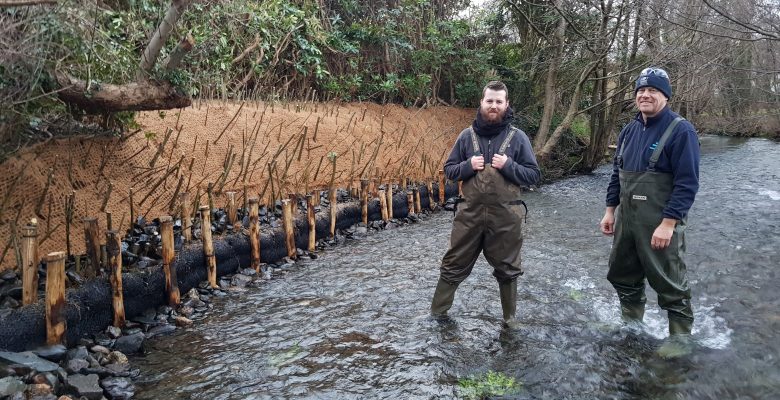As part of EcoNorth’s wide range of ecological services, we are proud to offer practical solutions to habitat management, including cases of stream or river bank erosion. Where the persistent waterflow is responsible for the removal of bank material and resulting bank subsidence, there are several soft engineering interventions to consider that create and enhance local habitat, improve aesthetics and provide affordable long term bank stabilisation.
On a recent project, a river course was retreating into a residential property and required immediate intervention to prevent further loss of land. The combination of a steep bank, sandy loose material and a susceptibility to flash flooding made the site particularly vulnerable. Following an initial site visit conducted by one of our Ecologists, required to identify any ecological receptors that would be directly affected by the intended works, a bespoke stabilisation solution was devised. The proposed works incorporated fixed revetment installations, soil erosion control materials and willow planting.
EcoNorth’s solution
The installation began with creating bank reinforcement, to provide support and prevent subsidence even during flood events. A series of opposing chestnut stakes were driven deeply into the toe of the bank forming an anchor for two tiers for aqualogs. These flexible two metre long logs are very durable, specifically in high energy aquatic environments, and comprise of a naturally occurring coal industry by-product which would otherwise be sent to landfill. The woody raw fibre material at their core is exceptionally long lasting, withstanding mechanical and biological degradation, but also provide an alternative habitat for aquatic fauna and flora.
Loose material at the top of the embankment was scrapped down behind the revetment to form backfill and to reduce the overall angle of the bank face. A shade tolerant grass mix (mixture breakdown: Perennial Ryegrass, Strong Creeping Red Fescue, Smooth Stalked Meadow Grass, Chewing Fescue and Sheep Fescue) was scattered across the freshly worked surface. With germination expected to occur within a matter of weeks, the early growth of a grass root network would complement the soft engineering installations as the grass becomes progressively more established.
A layer of natural coir fibre netting, a biodegradable by-product from the coconut industry designed for use in high velocity areas with minimal vegetation, was pinned across the length and breadth of the freshly seeded bank face. The netting will act as robust biodegradable surface protection, fixing the bank in place whilst minimising material scour during flooding events.
Rocks from the river bed were utilised to form a rigid foundation at the base of the aqualogs, as well as to bolster the weaker ends of the revetment, acting to divert the river course and prevent undercutting.
Although the exposure of the natural seedbank and the incorporation of shade tolerant grasses would be sufficient to maintain the bank face in the long term, we also employed the natural bioengineering characteristics of willow. Fresh cuttings of four different willow species (Purple, Cracked, White and Goat) were pinned across the entirety of the bank. These cuttings take hold rapidly in a wide variety of soil types, requiring only year-round moisture to promote a dense root network. The use of willow is often advocated for erosion control in sensitive river environments which are often subject to statutory designations. Soft engineering methods, such as willow spiling, are also favourable with respect to the requirements of the Water Framework Directive.
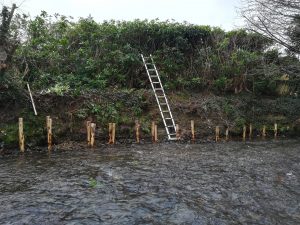
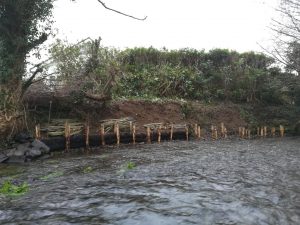
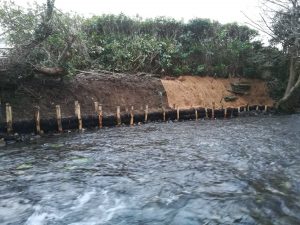
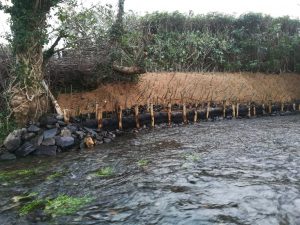
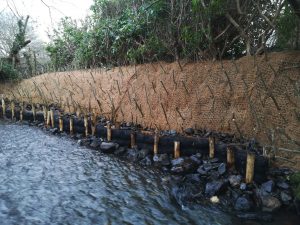
When should I get in touch with EcoNorth?
Soft engineering interventions may be implemented at any time of the year. However, like tree planting, the use of willow can only be undertaken during the winter months (October to March inclusive) before the cut willow starts to shoot. Therefore, this needs to be considered in relation to the phasing of your project if you are considering this option for your land or project. We are happy to undertake a site visit at any time of the year.
What do EcoNorth’s services include?
Initially, we will undertake a site visit to ensure that we offer you the most cost-effective solution tailored to your project. We will then pull together a fixed fee proposal outlining cost, logistics and timings.
Upon commission, we order materials, sort access logistics and undertake the erosion prevention process in a safe and timely manner.
Finally, we can undertake a site maintenance visit to ensure that the intervention is functioning in accordance with the agreed proposal. We will monitor the growth of any bioengineering species, specifically to identify if they have taken root, indicating the beginning of the long term bank stabilisation process.

